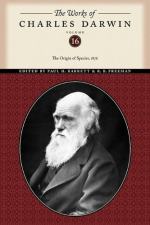
|
| Name: _________________________ | Period: ___________________ |
This test consists of 15 multiple choice questions and 5 short answer questions.
Multiple Choice Questions
1. What is one river that Darwin gives as an example of one that has dramatically changed over the years?
(a) Mississippi.
(b) Ohio.
(c) Nile.
(d) Rhine.
2. What species of bee builds the most efficient hives?
(a) Honeybees.
(b) Bumblebees.
(c) Hive-bees.
(d) Yellowjackets.
3. What is one of the most serious objections to natural selection?
(a) Religious objections.
(b) Darwin's credibility.
(c) Lack of links between species.
(d) Age of Earth.
4. What does the bone structure of the human hand resemble?
(a) Wing of a bat.
(b) Hoof of a horse.
(c) Fin of a fish.
(d) Paw of a dog.
5. How do biologists classify organisms?
(a) Groups of internal features.
(b) Groups of resemblance.
(c) Groups of functions.
(d) Groups of locations.
6. What happens to the offspring when two of the same distinct species interbreed?
(a) Fertile.
(b) Sterile.
(c) Eaten by parents.
(d) Migrate after birth.
7. Why might a hybrid species NOT survive birth?
(a) Physical deformities.
(b) It is half-related to the mother and has difficulty surviving in the womb.
(c) Poor respiration.
(d) Natural selection.
8. What is said about the pressure to adapt?
(a) It is equal among all species.
(b) It is dependent on the numbers in a species.
(c) It is not equal among all species.
(d) It is dependent on the region.
9. What does the fossil record suggest about species that go extinct?
(a) They go extinct quickly.
(b) They do not reappear.
(c) They reappear as a variation.
(d) They pass on their traits.
10. What does the fossil record show about new species?
(a) They are variations of fossils.
(b) They did not exist in ancient times.
(c) They did exist in ancient times.
(d) They are different species.
11. What insect does Darwin offer as an example of having a naturally selected trait that is NOT beneficial?
(a) Bee.
(b) Fly.
(c) Aphid.
(d) Spider.
12. At what point is it necessary for animals to display traits that distinguish them from other organisms?
(a) As an embryo.
(b) When they must fend for themselves.
(c) During childhood.
(d) During offspring-bearing age.
13. In addition to the Formica rufescens, what other ant species takes slaves?
(a) Mycocepurus smithii.
(b) Forelius pusillus.
(c) Formica sanguinea.
(d) Odontomachus bauri.
14. What behaviors have been lost through the domestication of cats and dogs?
(a) Eating chickens.
(b) Barking/meowing.
(c) Fighting.
(d) Breeding.
15. What seems unlikely, but must be possible concerning the migration of fish?
(a) Southbound migration.
(b) Upstream migration.
(c) Accidental dispersal.
(d) Fresh to saltwater migration.
Short Answer Questions
1. For natural selection to be true, what could be suggested about transitional forms?
2. What may occur if one organism changes dramatically over time?
3. In Geographical Distribution continued, what does Darwin suggest about the rule of natural selection?
4. What is the general quality of fossils gathered by paleontologists?
5. How do some scientists try to explain the purpose of rudimentary organs?
|
This section contains 526 words (approx. 2 pages at 300 words per page) |

|




